Welcome to a world where puzzles aren’t just for fun – they’re a serious business! Imagine a store making a staggering $6.5 million in just 9 months by selling jigsaw puzzles.
Sounds like a dream, right? But it’s not just a dream; it’s a reality that reflects the untapped potential of the jigsaw puzzle market.
Now, let me take you on a journey. A journey that will unfold the secrets of this booming business. Picture this: a store launched in June 2023 becomes a sensational hit. In less than a year, it’s not just surviving; it’s thriving with over 500 sales and an estimated revenue of $11,000.
It’s pulling in around 70 monthly sales, translating to about $1,500 in passive income. The most astonishing part? This success story is crafted with just 200 products!
But here’s where it gets even more exciting. We will not just talk about this success; we will replicate it. And the best part? We’re going to use the power of AI to make it happen.
In this guide, I’ll walk you through every step of starting your jigsaw puzzle business with AI. From ideation to creation and to launching your empire.
Read more: $11,000 in Your First Month? How Amazon KDP with AI Makes It Possible!
Understanding the Jigsaw Puzzle Market
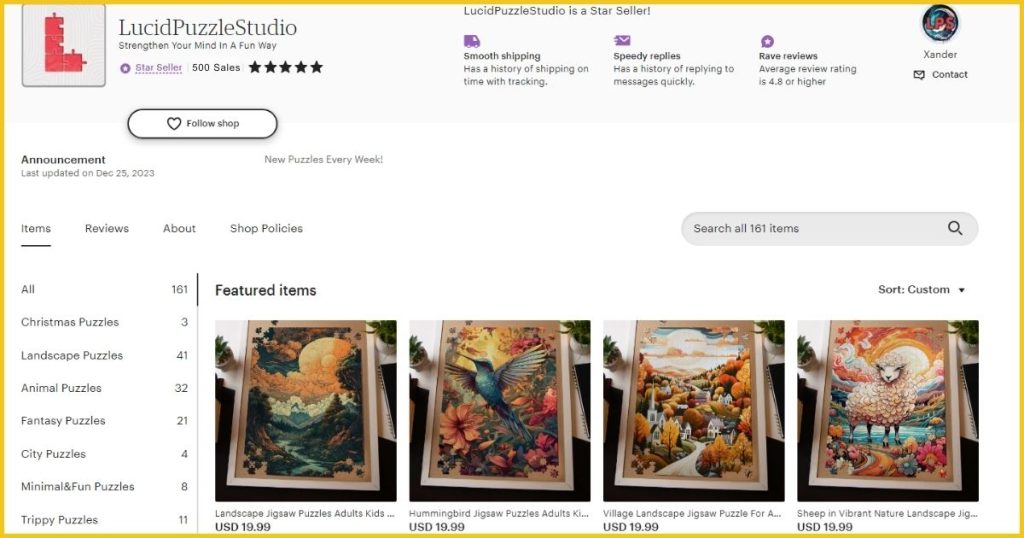
Let’s start with a deep dive into the jigsaw puzzle market, beginning with a remarkable success story. A store, just like any other, enters the market in June 2023. Fast forward 9 months, and what do we see?
A whopping 500 sales and revenue soaring to $11,000! This isn’t just impressive; it’s a testament to the market’s potential.
Now, let’s break it down. This store managed to average around 70 sales per month. That’s about $1,500 monthly in passive income. And remember, this success was achieved with a catalogue of merely 200 products.
It indicates that you don’t need endless products to strike gold in jigsaw puzzles. A well-curated selection can do wonders.
But what’s truly exciting is the broader picture of the jigsaw puzzle market. It’s not just about selling a product; it’s about creating experiences and memories.
People love puzzles for various reasons – the challenge, the nostalgia, or the sheer joy of piecing together something beautiful. This emotional connection makes jigsaw puzzles more than just another item to sell; they’re a gateway to engaging deeply with customers.
Moreover, the jigsaw puzzle market is broader than just children or puzzle enthusiasts. A growing trend of adults turning to puzzles as relaxation and mental exercise. This expands the market significantly, offering opportunities to cater to diverse demographics.
Identifying Winning Jigsaw Puzzle Themes and Trends
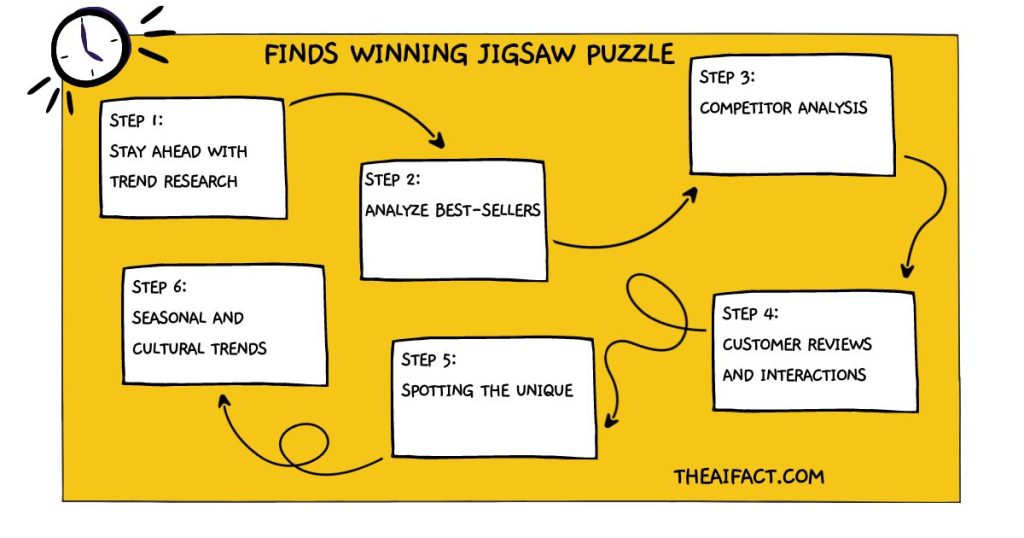
To succeed in the jigsaw puzzle market, the key lies in understanding what resonates with customers. Identifying the suitable themes and trends is crucial. Here’s how you can pinpoint winning ideas:
- Stay Ahead with Trend Research: The jigsaw puzzle market trends can be as varied as the puzzles themselves. From serene landscapes to abstract art, the themes are endless. Watch on social media, follow puzzle forums, and subscribe to industry newsletters. This will give you a firsthand look at what’s capturing people’s interest.
- Analyze Best-Sellers: Platforms like Etsy are goldmines for market research. Look for puzzles tagged as best-sellers. These are your benchmarks. They are not just popular; they are proven revenue generators. Study their themes, complexity, and customer reviews. What makes them stand out? Is it the artwork, the challenge level, or something else?
- Competitor Analysis is Key: Don’t reinvent the wheel. Instead, learn from those who are already successful. Browse through top-selling stores on Etsy and other platforms. Notice the common themes in their top products. Are they focusing on nature themes or maybe vintage styles? Understanding your competitors’ strategies can offer valuable insights for your product line.
- Customer Reviews and Interactions: This is where you get a peek into the minds of your target audience. Reviews can reveal what customers love and what they wish was different. Also, pay attention to products with high engagement, such as those with many people having them in their cart or those receiving consistent new reviews.
- Spotting the Unique: Sometimes, the winning theme isn’t the most popular one; it’s the unique one. Look for gaps in the market. A demand for puzzles in a niche area, like famous landmarks or specific art styles, may need to be adequately addressed.
- Seasonal and Cultural Trends: Don’t forget to consider seasonal themes or cultural events. Puzzles around holidays, seasons, or significant global events can be viral.
Remember, the key to success in this market is not just about finding what’s popular; it’s about discovering what connects with people on a deeper level.
It’s about finding that perfect blend of art, challenge, and storytelling that turns a simple puzzle into an experience.
Once you’ve identified these winning themes and trends, you’re on your way to creating a product line that sells and resonates with your audience.
Design Creation Using AI Tools

Embracing AI in the creative process is a game-changer for jigsaw puzzle design. Tools like MidJourney and ChatGPT offer incredible opportunities for innovation and efficiency. Let’s investigate how these tools can be used and compare their effectiveness.
Introduction to AI Tools for Design Creation:
- MidJourney: Known for its high-quality outputs, it can transform basic ideas into stunning visual designs. It’s particularly effective for creating intricate and detailed artwork, perfect for puzzles.
- ChatGPT: While primarily a language model, ChatGPT can assist in generating creative design ideas and descriptions, guiding the design process, and even tweaking existing designs.
Step-by-Step Guide to Using AI to Create Puzzle Designs:
1. Using MidJourney:
- Define Your Concept: Start with a clear idea of the theme or style you want for your puzzle.
- Craft Your Prompt: Write a detailed prompt describing your desired image, including style, elements, and mood.
- Run the AI: Input your prompt into MidJourney. The AI will generate several design options.
- Refine and Select: Choose the design that best fits your vision or use the outputs as a starting point for further refinement.
2. Using ChatGPT:
- Idea Generation: Ask ChatGPT to suggest unique puzzle themes or styles based on current trends or specific criteria.
- Description Writing: Use ChatGPT to write descriptive prompts for MidJourney or to create engaging product descriptions.
- Feedback and Iteration: ChatGPT can help refine ideas based on feedback, suggesting adjustments or alternative approaches.
Comparison of Different AI Tools and Their Effectiveness:
| Feature | MidJourney | ChatGPT |
|---|---|---|
| Primary Use | Generating high-quality, visually appealing designs | Assisting with the creative process |
| Strengths | Creating complex, detailed images | Brainstorming, refining ideas, creating narratives |
| Visuals | Excellent for visuals; can make puzzles stand out | Perfect for improving the narrative and conceptual aspect |
| Access | Require a subscription | Require a subscription (ChatGPT-4) |
| Suitability | Ideal for enhancing the visual aspect of puzzles | Perfect for enhancing the narrative and conceptual aspect |
| User Interaction | Primarily one-way in generating outputs | Interactive, aiding in idea development and refinement |
Manufacturing and Publishing Your Puzzle Designs
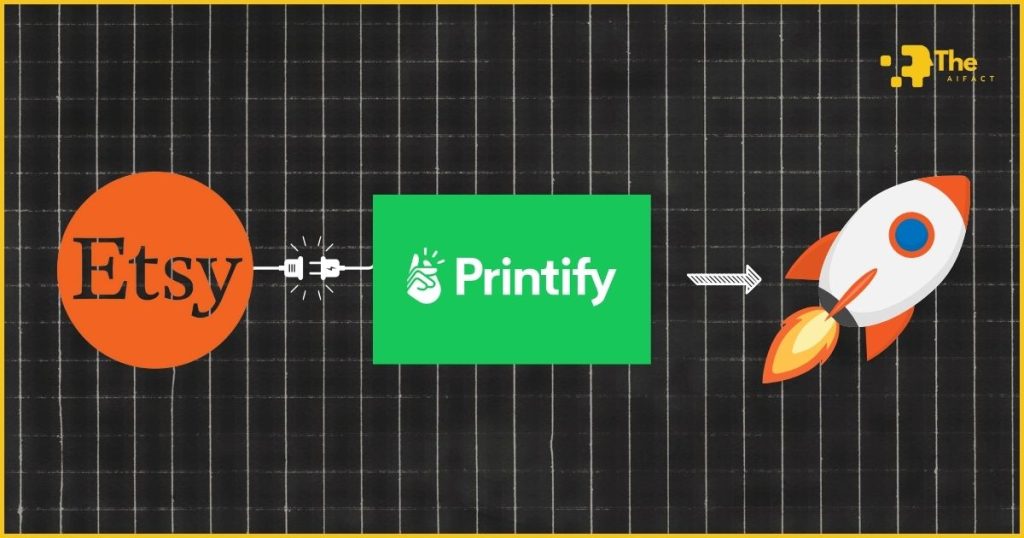
Once you have your jigsaw puzzle designs ready, the next crucial step is bringing them to life and getting them into the hands of eager customers. Let’s delve into the manufacturing process, how you can leverage platforms like Printify to streamline your production, and tips for setting up your Etsy store.
1. Understanding the Manufacturing Process:
- Selecting a Manufacturer: Choose a manufacturer that aligns with your quality standards and budget. Consider factors like production time, material quality, and cost.
- Quality Control: Ensure that the manufacturer has a robust quality control process. The durability and finish of the puzzles are crucial for customer satisfaction.
- Scaling Production: Start with a smaller batch to test the market response, then scale up production based on demand to avoid overstocking.
2. Using Printify for Production:
- Getting Started: Sign up for a free Printify account. This platform connects you with various print-on-demand manufacturers.
- Selecting Your Product: Browse through the puzzle options available on Printify. They offer a range of sizes and piece counts, catering to different customer preferences.
- Design Upload and Customization: Upload and adjust your puzzle designs to fit the product specifications. Printify’s interface allows you to visualize the final product.
- Setting Up Manufacturing: Choose a manufacturer from Printify’s network based on location, pricing, and quality. This ensures efficient shipping and production costs.
3. Connecting Your Etsy Store:
- Integration with Printify: Link your Etsy store to your Printify account. This integration allows for seamless synchronization of products and orders.
- Product Setup: Add your puzzles to your Etsy store through Printify. Customize each listing with high-quality images, detailed descriptions, and appropriate tags to improve discoverability.
- Pricing Strategy: Set competitive prices while considering manufacturing costs, Etsy fees, and your desired profit margin.
4. Launching on Etsy:
- Create Engaging Listings: Use compelling titles and descriptions. Highlight unique aspects of your puzzles, like the theme, the story behind the design, or the quality of the pieces.
- Optimize for Etsy’s Search: Use relevant keywords in your titles and descriptions. This helps your products show up in search results.
- Promotions and Marketing: Consider running promotions or using Etsy’s advertising tools to increase visibility when you first launch.
5. Order Fulfillment:
- Automated Process: When a customer orders a puzzle from your Etsy store, the order is automatically sent to Printify.
- Production and Shipping: Printify handles the production and ships the puzzle directly to the customer. This model eliminates the need for you to manage inventory or handle shipping.
By following these steps, you can streamline the process of manufacturing and selling your jigsaw puzzles. Platforms like Printify make producing high-quality products easy and connect with a global customer base through Etsy. With this setup, you can focus more on design and marketing, leaving the logistics of production and shipping to the experts.
Leveraging AI for Effective Marketing
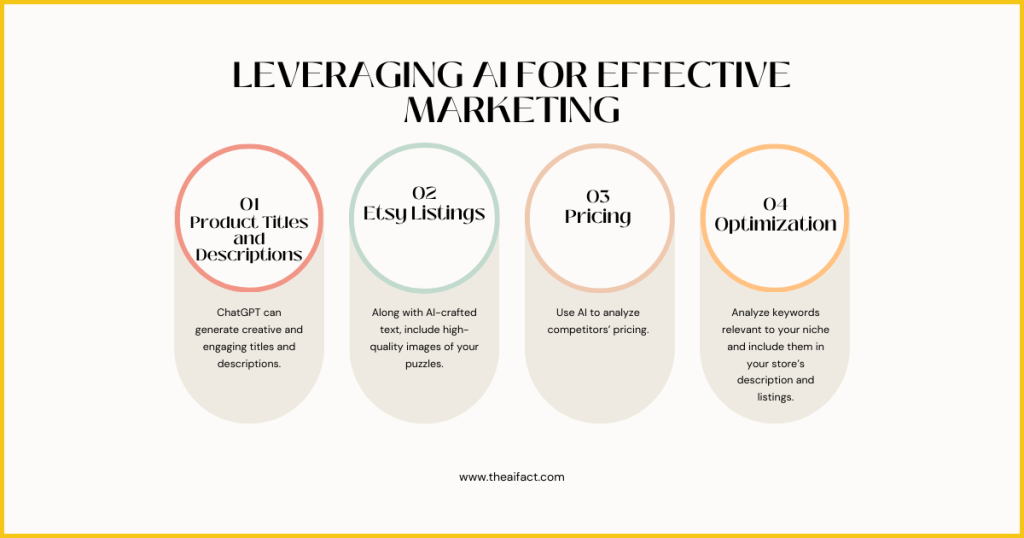
In the digital age, AI tools like ChatGPT can be potent for crafting marketing content that resonates with your audience. Let’s explore how you can use AI to enhance your Etsy listings and optimize your pricing strategy.
1. Creating Compelling Product Titles and Descriptions:
- Use AI for Inspiration: ChatGPT can generate creative and engaging titles and descriptions. Input your product details and ask for suggestions highlighting your puzzle’s unique features.
- Focus on Keywords: AI can help identify relevant keywords likely to attract your target audience. Incorporate these keywords naturally into your titles and descriptions for better SEO.
- Tell a Story: Use AI to weave a narrative around your puzzle. This could be the story behind the design, the experience of solving the puzzle, or the emotions it evokes.
2. Crafting High-Converting Etsy Listings:
- High-Quality Images: Along with AI-crafted text, include high-quality images of your puzzles. Use different angles to showcase the puzzle’s quality and complexity.
- Highlight Unique Selling Points: Use AI to help articulate what makes your puzzle unique. Is it the intricate design, the quality of the pieces, or an unusual theme?
- Customer Engagement: Encourage customer interaction by asking AI to create questions or prompts in your product description. This can increase engagement and potentially lead to more reviews.
3. Pricing Strategies and Competitive Analysis:
- Competitor Pricing Analysis: Use AI to analyze competitors’ pricing. Input data about competitors’ prices and ask for recommendations on pricing your puzzles competitively.
- Dynamic Pricing Models: Consider active pricing strategies. AI can help forecast demand trends, allowing you to adjust prices based on market conditions.
- Value-based Pricing: Ensure your price reflects the value of your puzzles. AI can assist in evaluating the perceived value of your products and suggest a price matching the quality and uniqueness of your designs.
4. Optimizing Your Etsy Store:
- SEO Optimization: Use AI to optimize your store’s SEO. Analyze keywords relevant to your niche and include them in your store’s description and listings.
- Customer Insights: Analyze customer reviews and feedback using AI. This can provide insights into customer preferences and areas for improvement.
By incorporating AI into your marketing strategy, you can create more effective, personalized, and engaging content for your Etsy store. AI tools offer a unique advantage in understanding market trends, optimizing search engine content, and crafting stand-out listings. These strategies can enhance your online presence, attract customers, and boost sales.
Launching and Scaling Your Jigsaw Puzzle Business with AI
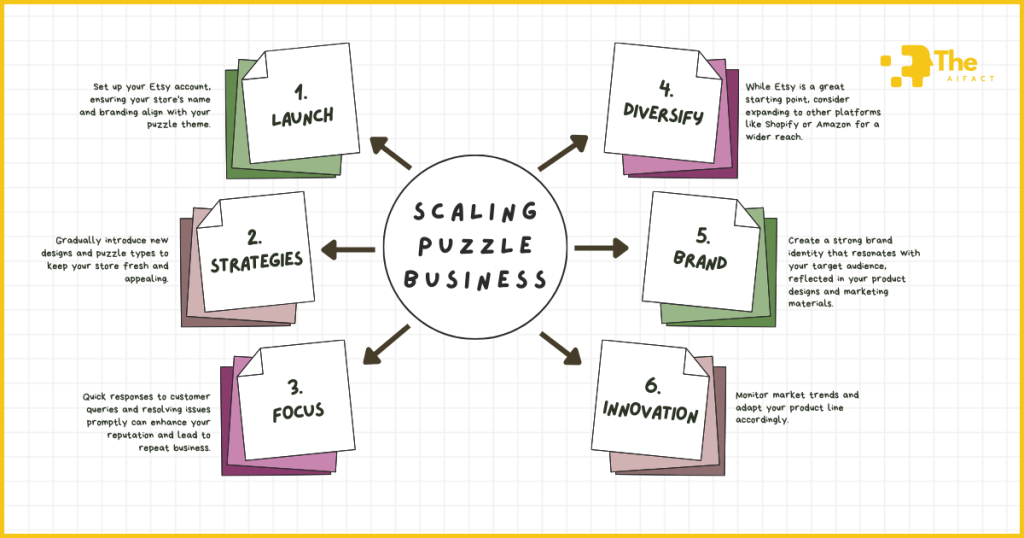
Launching and scaling a jigsaw puzzle business, especially on platforms like Etsy, requires a strategic approach. Here’s a guide to help you set up for success and grow your business effectively.
1. Steps to Launch Your Jigsaw Puzzle Business on Etsy:
- Create Your Etsy Store: Set up your Etsy account, ensuring your store’s name and branding align with your puzzle theme.
- List Your Products: Upload your puzzle designs using compelling titles and descriptions crafted with AI tools. Ensure high-quality images are used for each listing.
- Set Up Payment and Shipping: Configure payment methods and shipping options. Be transparent about shipping times and costs to avoid customer confusion.
- Launch Promotions: Consider introductory offers or discounts to attract your first customers and generate initial reviews.
2. Strategies for Scaling and Increasing Sales:
- Expand Product Range: Gradually introduce new designs and puzzle types to keep your store fresh and appealing.
- Utilize Etsy Ads: Invest in Etsy’s advertising platform to increase the visibility of your top-selling or unique puzzles.
- Engage with Your Community: Actively engage with customers through Etsy conversations, social media, and email newsletters.
- Leverage Analytics: Use Etsy’s analytics tools to understand customer behavior and preferences, adjusting your strategy accordingly.
3. Focus on Customer Service and Product Quality:
- Prioritize Customer Satisfaction: Quick responses to customer queries and resolving issues promptly can enhance your reputation and lead to repeat business.
- Gather and Act on Feedback: Regularly seek customer feedback and reviews, using this information to improve your products and service.
- Quality Assurance: Consistently ensure that the puzzles you sell meet high-quality material, print clarity, and packaging standards.
4. Diversify Sales Channels:
- Explore Other Platforms: While Etsy is a great starting point, consider expanding to other platforms like Shopify or Amazon for a wider reach.
- Offline Opportunities: Look for opportunities to sell in local stores, at craft fairs, or through puzzle clubs and groups.
5. Building a Brand:
- Develop a Unique Brand Identity: Create a strong brand identity that resonates with your target audience, reflected in your product designs and marketing materials.
- Social Media Presence: Utilize social media platforms to build a community around your brand, showcasing new designs, behind-the-scenes content, and customer stories.
6. Innovation and Adaptation:
- Stay Informed on Trends: Monitor market trends and adapt your product line accordingly.
- Innovate: Don’t be afraid to try new ideas, whether unique puzzle themes or interactive elements.
Launching a puzzle business on Etsy is just the beginning. The key to long-term success lies in consistently delivering quality products, exceptional customer service, and adapting to market changes and customer needs. With the right strategies, your puzzle business can grow from a small Etsy shop to a well-recognized brand in the jigsaw puzzle market.
Particular Focus: The $40,000 Listing
Let’s zoom in on a spectacular case study – a personalized puzzle listing that astonishingly generated over $40,000 in revenue. Understanding the elements that contributed to its success can offer invaluable insights for replicating similar triumphs in your puzzle business.
1. Overview of the Successful Listing:
- This listing featured personalized puzzles, where customers could have their photos turned into jigsaw puzzles.
- It stood out due to its unique value proposition – offering a personal touch in a product that’s usually generic.
- The listing was complemented by high-quality images and compelling descriptions communicating its uniqueness and value.
2. Critical Factors Behind the Listing’s Success:
- Personalization: The option to personalize puzzles created an emotional connection with customers, making it a perfect gift or keepsake.
- Quality Imagery: The listing used professional, transparent, attractive photos showcasing the finished product and the personalization aspect.
- Engaging Description: The product description was detailed and persuasive, highlighting the uniqueness of a personalized puzzle.
- Positive Reviews: The listing built trust and credibility with potential buyers by accumulating many positive reviews.
3. Replicating This Success in Your Business:
- Offer Personalization: Consider offering personalized puzzles in your store. Use tools like AI to help suggest creative personalization ideas.
- Invest in Photography: High-quality images are crucial. They should accurately represent the product and entice customers to imagine the product in their lives.
- Craft Compelling Descriptions: Use storytelling in your descriptions to connect with your customers emotionally. Highlight the specialness of having a personalized puzzle.
- Gather and Showcase Reviews: Encourage customers to leave reviews and showcase them prominently. Positive feedback can significantly influence buying decisions.
- Marketing Strategy: Use targeted marketing strategies to promote your personalized puzzles. This can include social media advertising, influencer collaborations, and email marketing campaigns.
- Customer Service: Provide excellent customer service, especially for personalized items. Ensure clear communication and a smooth process from ordering to delivery.
4. Leveraging Social Proof: Utilize the power of social proof by sharing customer stories and photos of the finished puzzles. This serves as a testimonial and provides real-life examples of the product.
5. Continuous Improvement: Regularly seek feedback to improve the personalization process and the product’s quality. Stay updated with printing and manufacturing technologies to enhance the final output.
The success of the $40,000 listing can be attributed to its unique personalization feature, exceptional presentation, and robust marketing and customer service strategies. By incorporating these elements, you can create a similarly successful listing in your jigsaw puzzle business, offering products that sell and create meaningful customer experiences.
Conclusion
As we reach the end of our journey through the intricacies of the jigsaw puzzle business, it’s clear that this niche holds immense potential. The success stories, the strategies, and the tips shared are not just words; they are a blueprint for a thriving business venture in a market that blends creativity, nostalgia, and innovation.
The jigsaw puzzle business is not just another e-commerce opportunity; it’s a chance to create and share joy. Each puzzle piece is part of a story waiting to be told, a memory waiting to be cherished. Whether through personalized puzzles that capture life’s precious moments or unique designs that challenge and inspire, this business offers something unique.
I encourage you to embrace AI and creativity as your allies in this venture. Let AI streamline your processes, from design creation to marketing, freeing you to focus on the creative aspects that make your puzzles unique. Use tools like MidJourney and ChatGPT to bring efficiency and innovation to your business.
Remember, starting a business is about taking that first step. It’s about turning ‘one day’ into ‘day one.’ So, if you’re passionate about puzzles and eager to embark on an entrepreneurial journey, now is the time to start your jigsaw puzzle business.
The market is ready, the tools are available, and the opportunity is yours. Dive into this venture with the insights and strategies you’ve gained, and watch your puzzle business come together, piece by piece, into a beautiful picture of success.

